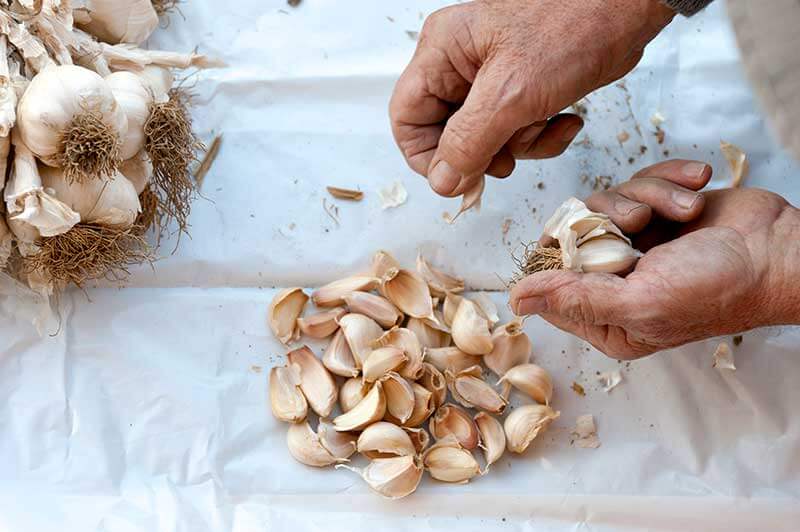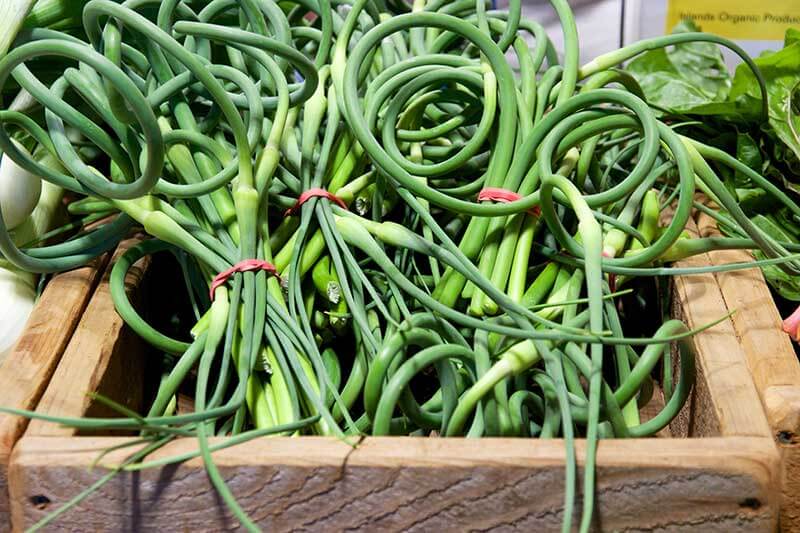How to Plant, Grow and Harvest Garlic
- Choosing Your Garlic Type
- Timing Your Garlic Planting
- Preparing Garlic Planting Beds
- Planting Your Garlic
- Caring for Garlic as It Grows
- Harvesting and Storing Garlic
Choosing Your Garlic Type
Garlic comes in many varieties, so you can choose one or more to suit your palate and your meal plans. True garlics fall into two main categories:
- Hardneck garlics get their name from their hard center seed stalk, called a scape. They typically have a strong or hot flavor, but a shorter storage life: three months at most after harvest. Cloves in hardneck heads usually number 12 or fewer.1 Large and uniform, hardneck cloves grow in a single layer around the stiff stem.
- Softneck garlics don't form a hard center stalk; their tops stay soft and supple. If you plan to try your hand at creating garlic braids — like those you see hanging at farm markets — softnecks are for you. Softneck garlics offer a milder flavor than the hardneck type, and they store for six months or longer. Softneck heads consist of up to 40 small, irregular cloves in multiple layers around the center.1
It's generally best to buy your planting garlic from local garden companies so the varieties will suit your climate. Supermarket garlic can work, but it often comes from California or overseas and doesn't do well in garden plantings outside those areas.

Timing Your Garlic Planting
Garlic can be planted in fall or early spring. However, like tulips and other spring-blooming bulbs, garlic needs chilly weather to develop properly. Without a chilling period, garlic heads don't divide into cloves and you end up with onion-like bulbs instead. If you plant in spring, plant garlic alongside your earliest vegetable seeds so garlic gets the chilling it needs. Many gardeners prefer to plant garlic in fall, when they plant flowering bulbs. This gives garlic added growing time, which means larger, more flavorful summer harvests — and nature makes proper chilling easy. Plant fall garlic from two weeks before or after the typical first frost date in your area. If you're unsure when that usually happens, your local county extension agent can help.

Preparing Garlic Planting Beds
Garlic grows best with full, direct sun and loose, fertile, well-drained soil. Abundant harvests depend on solid plant nutrition. Enhance your garden beds with a generous 3- to 4-inch layer of organic matter, such as compost. Incorporate this layer down into the soil along with a balanced fertilizer, such as Pennington Rejuvenate Plant Food All Purpose 4-4-4, to revitalize your soil with essential nutrients. It's a good idea to do a soil test before you plant. Your extension agent can help with this, too. Garlic is very efficient at using nutrients when soil pH is in the near-neutral range of 6.0 to 7.0.1 Soil testing lets you know exactly how to amend your garden soil so garlic can thrive.
Planting Your Garlic
Unlike vegetables grown from seeds or plants, garlic is grown from single cloves — the same cloves you use in cooking. Each clove grows into a full head. Prep cloves by hand right before planting time — and invite friends to help. It's a great excuse for a garden party with a garlic menu! To prepare the cloves, remove the garlic head's papery outer layer, then gently and carefully pull the cloves apart. Leave the papery covering on individual cloves, and avoid damaging their flat bottom plates — that's where the roots will grow. If a few get damaged, don't worry; just set them aside to use in meals. Plant garlic cloves 1 to 2 inches deep in warm climates or 3 to 4 inches deep farther north. Place the flat, rooting plate down into the soil so the pointy end of the clove sticks up. For fall plantings, add a 4- to 6-inch layer of weed-free mulch. Grass clippings, leaves or straw work well. This helps prevent wide fluctuations in soil temperatures so garlic cools gradually in fall and warms gradually come spring.

Caring for Garlic as It Grows
Fall-planted garlic peeks through mulch about the time early spring songbirds arrive. Gently pull mulch away from the growing leaves. Once leaves reach about 6 inches tall, add a layer of compost alongside them, and feed again with the same fertilizer used at planting. For spring plantings, do this about one month after planting. Keep garlic weeded; it doesn't compete very well against garden weeds. Water garlic so it gets about 1 inch of water per week from rainfall and your irrigation combined. Cut off hardneck scapes in early summer while they're curly and soft. Scapes are excellent in stir-fried or sautéed dishes. Plus, removing scapes helps bulbs grow larger. As your garlic matures and its leaves begin to yellow, stop watering completely to harden bulbs. Few insects bother garlic, but those that do can cause serious problems. Sevin Insect Killer Ready To Use2 kills garlic pests such as cutworms, leafminers and onion thrips on contact. Just allow at least 14 days between treatment and your garlic harvest. Fungal diseases can also interfere with garlic plans. The first trouble signs are often small tan, white or purple spots on garlic leaves. Daconil fungicides provide highly effective control for garlic diseases such as botrytis blight, downy mildew or purple blotch.

Harvesting and Storing Garlic
Depending on where you live, your garlic harvest may happen any time from July through September. When stems turn yellow and fall over, and the bottom few leaves turn brown, it's harvest time. Carefully dig your garlic bulbs, keeping the stems intact. To maximize storage life, "cure" your harvest in a warm, dry, shaded area with good ventilation. Just tie the stems together and hang garlic to dry or spread out the heads in a single layer. After two to four weeks, your garlic is ready for optimal storage. Cut the stems off about 1 inch above the bulbs, or braid long-stemmed softneck garlics for fun or gifts. Refrigerators provide the ideal temperature and humidity for long-term garlic storage, so your harvest keeps giving for months. Be sure to set aside some bulbs for your planting stock. With a treasure of homegrown garlic at your disposal, you can enjoy these flavorful veggies in many ways — from smoky, roasted heads to fresh garlic pestos and garlic-infused oils. GardenTech brands and the GardenTech blog are here to help you learn, grow and enjoy all the benefits and fun gardening has to offer.

Cure garlic with its tops intact in a dry, ventilated space.
Always read product labels thoroughly and follow instructions carefully, including guidance on pre-harvest intervals. Sevin is a registered trademark of Tessenderlo Kerley, Inc. Daconil is a registered trademark of GB Biosciences Corp. GardenTech is a registered trademark of Gulfstream Home and Garden, Inc.
1. E. Everhart, et al., "Garlic," lowa State University Extension, February 2003.
2. UC IPM Statewide Integrated Pest Management Program, "How to Manage Pests: Onion and Garlic," University of California, June 2016.
Get Monthly Gardening Advice!





